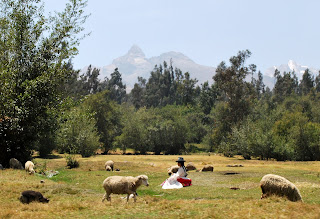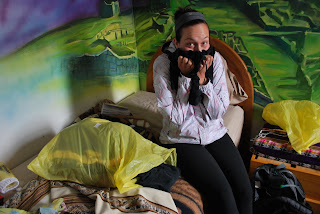From Huacachina we headed to Pisco, a city ravaged by the 2007 earthquake. The city still looked as though the earthquake had just happened; a testament to how bad it must have been 3 years ago. More than 80% of the city was flattened, including the main cathedral. The bus trip from Huacachina to Pisco was unnecessarily complicated; we were literally dropped off at side of the road and took a "collectivo" (cheap taxi) the rest of the way. Our Lonely Planet guide failed us badly with transportation options; and we tried just about every bus company before finally finding one that would take us there for a reasonable price. It all worked out in the end.
Fun fact; there are probably more stray dogs than children in peru, and they are everywhere, including the rooftops, where they chase cars as they drive by.
We refined our barterring skills, and managed to get a deal on both the hostel room and the tours that
we booked for the next day to Isla Ballestas ("Poor Man's Galapagos") and Paracas National Reserve. We went to El Dorado for dinner; a local seafood restaurant with a good reputation. Alex proudly spoke her first spanish sentence; "quiero el ceviche mixta sin cebolla" (I would like the mixed ceviche.. without onions"), and Lisa ordered Pescado Sudado for the thrid time in two days (can't get enough of that dish!). It was a delicious meal, and the fact that the power went out shortly after we got our food (and remained out for the evening) only made the experience more authentic.
we booked for the next day to Isla Ballestas ("Poor Man's Galapagos") and Paracas National Reserve. We went to El Dorado for dinner; a local seafood restaurant with a good reputation. Alex proudly spoke her first spanish sentence; "quiero el ceviche mixta sin cebolla" (I would like the mixed ceviche.. without onions"), and Lisa ordered Pescado Sudado for the thrid time in two days (can't get enough of that dish!). It was a delicious meal, and the fact that the power went out shortly after we got our food (and remained out for the evening) only made the experience more authentic.
We would have liked to take more photographs of Pisco, but since the earthquake the crime in the city has skyrocketed, and it would have been foolish to have the Nikon out.
The next day we went on a tour of Isla Ballestas; we saw penguins, sea lions, pelicans, cormorants, boobies, and so many other species of birds. The islands are of great value to Peru because every 7 years, the extensive layer of guano (cormorant "excrement") is scraped off the islands and sold for an exorbitant price as high-grade fertilizer. Smells fantastic!
Next, we went to visit Paracas National Reserve with it's magnificent desert landscapes. The entire area was once a seabed, and the scorched sand earth (which receives an annual precipitation of 1.8mm) is littered with fossilized shellfish remains.
Here is a picture of a famous rock monument off the coast of Paracas park; after and before the 2007 earthquake. (F.Y.I. Lisa took the "after" picture, and the "before" picture was on a poster).
We visited the only red sand beach in peru; formed from the adjacent cliff of magnesium carbonate. The beach is protected and you couldn't walk on it, but the colors were unreal.
We stopped at a local fishing village for lunch (also completely devastated by the earthquake and subsequent 7meter-high tsunamis). Like much of the area, destroyed buildings haven't been removed; they are either just left as skeletons, or have been built onto (or inside of). It's a bit eerie.
The harbor was littered with fishing boats; more boats that we could count people in the village in fact. We're not sure where everyone was.
Local restuarant would toss their fish scraps out the backdoor, and groups of eager (and vicious) pelicans would wait impatiently at the back (or front) doors.
From Pisco we headed back up to Lima to catch our flight to Cuzco. We stayed in yet another amazing hostel (Hostal Espana) in downtown Lima; a huge hostel built in a 400-year old converted colonial mansion. There we marble pillars, chandeliers, paintings (originals!) everywhere, huge ceilings, original hardwood floors, and statues everywhere. We paid $8US each for this huge private room!
We flew from Lima to Cuzco on Peruvian airlines (on a brand-new plane!), and arrived safely in Cuzco yesterday. We spent the day exploring the city and tomorrow we head off on our 5-day trek of the Sacred Valley and the Inca Trail up to Macchu Picchu!


















































